Acer Predator
Our final competitor in this 3-way comparison comes courtesy of Acer. It may seem an unusual choice in a round-up with two custom-boutique PCs, but despite being a manufacturer system, the Predator will certainly be able to hold its own against the competition in both specs and price. What we're interested in finding out is how well it fares in terms of the quality of components used, attention to detail and the level of customer service before and after the purchase.
The Acer Aspire Predator G7750 is currently the only gaming system listed on Acer's website and it's available though third party retailers in a single non-configurable version.
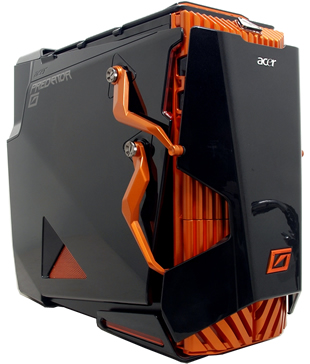
Excluding the monitor, the Predator shipped with everything you need to get your system up and running. Included in the retail box is the chassis, Logitech G11 keyboard, Logitech G5 wired gaming mouse, three different SLI bridges, a DVI adapter, power cable, weight system for the mouse and an instruction manual.
In the case of the Predator its components add up to around $1,510 if bought separately, which means you'll be paying a premium of around $320 for buying this system off-the shelf. This is the lowest premium of all three but comparatively speaking you get a few lesser quality components – the power supply, for example – and won't receive the same level of personalized service or configuration options with your purchase.
Acer has certainly gone over the top with the design aesthetics of the Predator. Contrary to its name, however, the chassis resembles a Transformer more than a Predator. It will fit a niche market, I'm sure, but minimalists need not apply.
Certain areas of the Acer Predator's chassis light up when the system is turned on. The front bezel is a cover that lifts up and rests on the top of the case, revealing the system's "real" front bezel. Underneath the cover you'll find a triangle-shaped power button and two optical drive bays with doors that open out like a claw, a card reader with provisions for CF, CF+, MMC, RS-MMC, SD, miniSD, xD, Memory Stick / PRO / Duo / PRO Duo and FireWire. Then at the bottom is a swing-open door that reveals four easy-swap hard drive bays. The 1.5TB hard drive is installed in the right-most bay.
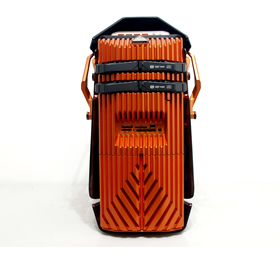
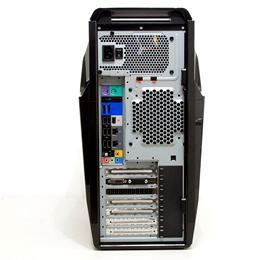
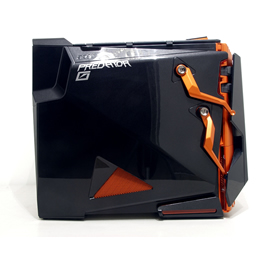
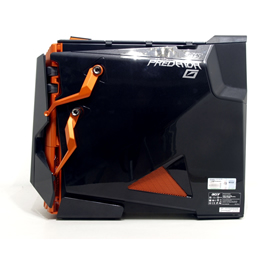
The right and left side panels are virtually identical with angular designs, glossy metallic flake paint and two arms that attach to the front bezel. Looking at the rear of the system we find a top-mounted power supply and an I/O panel with the following connections: PS/2 keyboard and mouse, clear CMOS button, two eSATA ports, six USB 2.0 ports, FireWire port, dual Ethernet Jacks, S/PDIF jack and audio ports. Unlike on the Maingear systems, there are no USB 3.0 ports.
The Nvidia GeForce GTX 470 is the only add-in card in the system and it features a single DVI port as well as an HDMI port. On top of the chassis are four USB 2.0 ports and microphone / headphone jacks.
As you can imagine, getting inside the Predator is a bit of a task due to the front bezel arms and the sheer size and shape of the side panel. First you need to remove the two large screws that hold the arms in place. Once this is done, there are two levers on the back that need to be unlatched to allow you to slide the panel off.
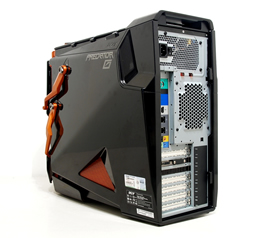
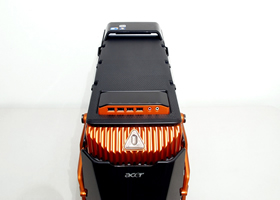
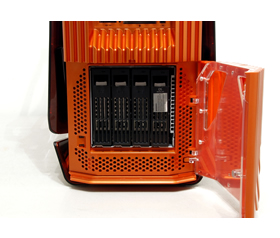
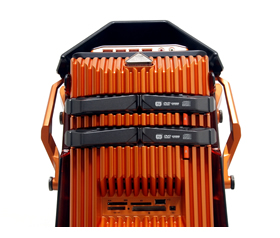
With the side panel removed we can get a good look at the internals of the Predator system. To our surprise beneath the flashy exterior we found that the system is basically just built on a standard ATX chassis. Acer has included clear orange pieces inside the system which I assume are to either aid in wire management or airflow. This is one area where we see the benefit of a custom build. The internals here look pretty messy compared to the two other systems.
Removing the side panel was a real chore, but reinstalling it proved next to impossible. The bulky side panel molding makes it very hard to line up when reinstalling, so after a while I simply gave up on trying and left it the best I could.

The Predator came with a copy of Windows 7 Home Premium 64-bit pre-installed, just like the other two systems in our round-up. However, this time around there were also a few pre-installed applications, which is pretty much a given with manufacturer PC. Along with a few Acer branded applications that might come handy like Backup Manager and the Acer Updater, there was also eBay Worldwide, eSobi v2, Google Toolbar, Identity Card, McAfee Security Center, MyWinLocker, Norton Online Backup and Welcome Center.
There was also a Netflix icon on the desktop for a quick sign-up of their service. The bloatware on the Acer Predator is somewhat light compared to the average OEM system, but the fact remains this is not something you have to fool with when going the custom build route. Furthermore, you are required to create your own recovery discs with the Acer system. Both Puget and Maingear include these in the bundle as well as the actual Windows installation disc.
